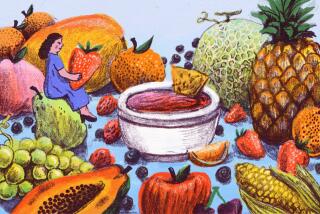Mangoes Are Blushing With Nutrients
- Share via
In last week’s column we talked about papayas, which, although gaining in popularity in the United States, are still among the lesser-known fruits available in our marketplaces. Mangoes also fall into that category.
*
Many Americans still consider mangoes to be an exotic fruit, but in tropical areas, they are as common as apples.
Mangoes originated in Southeast Asia about 4,000 years ago, and India is still the major producer, growing more mangoes than all other fruits combined. In the 10th century, Persian sailors are said to have taken the mango to East Africa and, some 600 years later, travelers from Portugal took them to West Africa and South America. By 1775, mangoes had been introduced to Mexico, where they are now an important export crop.
Most of the mangoes consumed in the United States come from Mexico, Haiti and Guatemala during the period of February through September. In 1999 alone, 360 million pounds were shipped here from Mexico. About 10% of the commercial crop comes from Florida, where the growing season is May through August, with the peak occurring in June and July.
*
Mangoes are a great nutritional bargain. They have 50% more beta carotene than an equal-size serving of apricots, and 21% more than cantaloupe, enough to provide almost 80% of your vitamin A requirement. They are also high in vitamin C. In addition, they are a good source of potassium. And yet, one serving (half a mango) has only 70 calories.
Mangoes come in hundreds of varieties and a wide range of shapes, colors and sizes. Some of the biggest ones can weigh up to 4 pounds or more. Among the most popular Mexican varieties are the following, and if they’re not identified by name in the store, ask the produce manager to tell you which is which:
* Hayden (turns yellow, with an orange or red blush when ripe).
* Tommy Atkins (turns red or yellow when ripe, is more fibrous than the others and has a blander taste).
* Kent (turns yellow or remains green when ripe, with a few hints of color).
* Keitt (stays green when ripe and may have a slight yellow blush).
* Ataufo or Honey Manila (remains yellow).
*
The size of a mango is determined by the variety. A ripe mango will yield to slight pressure when you hold it between your hands. It should look plump and round, and if you sniff the stem, you should detect a lovely tropical aroma. If the fruit smells fermented, don’t bother to take it home. The skin should show a blush of color (depending on variety) that will deepen as the fruit ripens. Except for the Keitt, which always stays green, a greenish-gray skin usually indicates that the mango will not ripen properly. Some black specks are normal, but too many of them may indicate damage to the flesh underneath. If the skin is loose or shriveled up, your mango has passed its prime.
You can easily ripen mangoes at home by leaving them at cool room temperatures for a few days. If you need to speed up the process, put two mangoes in a plastic bag. Once they are ripe, you can keep them in the refrigerator for two or three days.
*
Mangoes are extremely juicy, and the flesh clings to the large, flat pit. If you try to eat it like a peach, you will need lots of napkins. However, there are a few good techniques that are advocated by the mango experts:
* To slice: With a sharp thin-bladed knife, cut off both ends of the fruit; place fruit on flat end and cut away peel from top to bottom along the curvature of the fruit; slice fruit by carving lengthwise along the pit.
* With a spoon: Use a sharp knife to slice off the “cheeks” lengthwise down the mango on either side of the pit; separate halves, saving the tasty center; use spoon to scoop out fruit.
* To cube: Start with the “cheeks,” cut off the pit lengthwise; cut one-quarter-inch squares by scoring the mango with a sharp knife, but do not cut through the skin; turn the mango half inside out, separating the cubes; slice off the squares with a knife under the skin.
Finding ways to use mangoes may be easier than finding the mangoes themselves. Ripe mangoes have a flavor that is reminiscent of peaches and pineapples. They are best if eaten slightly chilled, and sprinkling them with lemon or lime juice brings out the flavor even more. They are a wonderful addition to a fruit salad. They can be cubed and put over pancakes, and they add a special flavor to shakes and smoothies. For homemade ice cream and sorbet fans, there is probably nothing better than mangoes to produce a refreshing summer treat.
Underripe mangoes can be cooked into pies and tarts, just like apples or peaches.
And last but not least, there is an unlimited number of versions of fresh mango chutney that make incredible additions to any kind of meat, poultry or fish. You can even create your own cooked chutney by simmering brown sugar, vinegar, hot peppers and ginger with mangoes and raisins.
If you’d like a copy of a wonderful low-fat recipe for a Cold Curried Mango Soup (perfect for dinner on a hot summer night), send a self-addressed, stamped envelope to Dale Ogar, School of Public Health, UC Berkeley, Berkeley, CA 94720-7360. Be sure to mark it “Mango.” You can also receive a copy by e-mail (see below).
*
Dr. Sheldon Margen is a professor of public health at UC Berkeley; Dale A. Ogar is managing editor of the UC Berkeley Wellness Letter. Send questions to Dale Ogar, School of Public Health, UC Berkeley, Berkeley CA 94720-7360, or by e-mail to daogar@uclink4.berkeley.edu. Eating Smart runs every Monday.
More to Read
Eat your way across L.A.
Get our weekly Tasting Notes newsletter for reviews, news and more.
You may occasionally receive promotional content from the Los Angeles Times.










